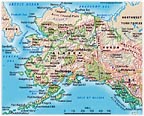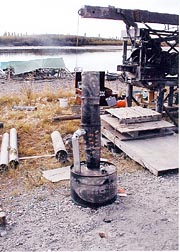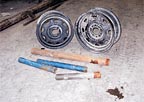
On the job, well drillers often are required to spend a portion of their time waiting for parts to come in or forfeit a sizable sum of money to acquire the tools and equipment necessary to complete the project. Cable tool driller Gary Fisher of Glennallen, Alaska, who works in some of the remotest parts of the country, has developed an ability to adapt the tools he has to complete a task. He downplays his capacity to innovate and considers it necessary, almost a job requirement.
His can-do attitude and strong work ethic have allowed Fisher to accomplish what he has. “Over the years, I’ve more or less become an expert in being able to modify tools and equipment in order to get the job done,” Fisher explains. “You get out there, and just because you don’t have the right fitting or this or that or the other thing, you make do with what you’ve got. I’m very good at using materials at hand to build something that’s functional.”

“I have never seen another one at any other drilling outfit,” Fisher states. “I wonder why people don’t do this more often.” He has decided not to pursue patenting his creation. When asked why not, he explains, “If you take a look at the design of it, all somebody would have to do is change the dimensions of it, and it would no longer be a patentable item. It’s not really a patentable item, it’s just an item that makes your work a little easier. I have no aspirations to patent it — I just thought it might be a good idea to let somebody else know about how to do it.”
Fisher considers the ability to modify tools and create new ones an essential skill for anyone in the drilling industry. “You know,” he shares, “this is the only industry, especially being a cable tooler, that you have to know how to do all this stuff if you’re going to be effective.” Armed with this attitude, he is very well suited to his trade and his environment.

Another of his designs is something to help escape the weather. Otherwise known as salamander heaters, these units originally were used for sludge pots to keep orchards free of frost, but people would buy salamanders for heating purposes. To keep warm, they would create little shacks by taking four pieces of plywood, adding hinges, and putting on an accordion-like top. With the salamander heater on the outside, they can stay warm and keep their gloves dry inside the buildings they constructed. Although Fisher did not invent them, when they were no longer available for purchase, he decided salamanders could be made. “Since I couldn’t buy them anymore, I figured, ‘Well, I can build that.’ And I have built a few of them, and I’ve sold a few,” he says. Unable to market them as heaters due to their unregulated design, he calls them modified 55-gallon drums. According to Fisher, his modified 55-gallon drum serves a practical purpose, “It’s a lot less expensive than trying to run power cords, power generators and space heaters. You can burn anything in them, gasoline, waste oil or whatever. In the villages that I work in, there’s a lot of waste oil, so if we can burn it, fine — it saves us two or three dollars a gallon for diesel fuel.”

As he states, water well drilling appealed to him because, “It was something out of the ordinary. I’m kind of an unconventional guy anyway and wanted to do something that was different.”
Fisher’s career has afforded him opportunities to do something different than most. In the early 1980s, a job with MW Drilling took him to the end of the Alaskan Peninsula, to Cold Bay. “As a result,” reveals Fisher, “I started doing a lot of work in very remote areas of Alaska, in areas accessible by air or by barge.”
“I mean very remote, very Spartan,” he emphasizes. “We take a rig in there and stay until the project’s done.”
He has continued his work drilling in isolated places and offers examples: “I drilled a water well on the island of Attu, which is the last island in the Aleutian chain, which is past the International Date Line. I spent quite a bit of time in Cold Bay, which is just this side of the International Date Line. I drilled a well up at Pump Station Four, which is above the Brooks Range. So I bet I’m the only driller in the world who’s drilled farther east, farther west and farther north than anybody else.”
Drilling in remote areas presents a challenge — getting the rig to the site. In areas with limited accessibility, often the rig must be flown in, which according to Fisher can mean disassembling the rig, taking it inside the airplane, then reassembling it at the site.
He discusses one such project and describes his taking a basic rig, building a pipe frame out of well casing and other available materials, creating a pipe stand to enable drilling and making it so the entire unit would fit in a plane. He further explains, “This rig was transported by a CASA 212; it’s got a 5-foot door in it, so we had to make it so when they go to transport the rig again — the frame, the rig, the mast and everything — can go in the airplane. The next person who drills with the rig now doesn’t have to figure out how to block it up as it was made to tear down or skid from place to place.”
Because his remote drilling projects involve complicated logistics, Fisher chooses to work for many different contractors. As he states, “What I can’t handle, I don’t need, and I don’t need somebody sitting in an office for a job I’m working. The contractors I work for usually are really good at providing the logistical support that I need out there.”
“Anymore, if I go out to the villages I demand a helper, ” he continues, describing his work arrangements. “I’ll be 59 in April. You know, I’m still able to do this stuff, but I’d prefer not to have to do the physical work, like digging out the mud pit. If I have to drive in guide-wire stakes, I prefer to have someone else swing the hammer. I’m very good at being able to direct people, even if they have no skills at all, about what I want done. I get a lot done — I get two-and-a-half times the work with a helper than I do by myself.”
Following the five Ps, “prior planning prevents poor performance,” Gary Fisher has mastered the ability to do whatever is necessary to make sure a job gets done. His next goal is to spend winters overseas in developing countries drilling and teaching people how to drill wells. With his innovative approach to every job he tackles, he’ll be sure to achieve his next task.
Report Abusive Comment